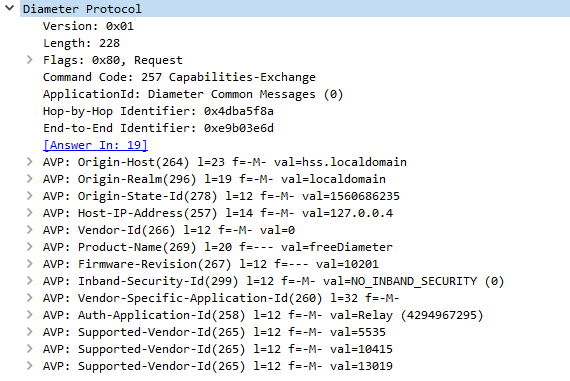3GPP selected Diameter protocol to take care of Authentication, Authorization, and Accounting (AAA).
It’s typically used to authenticate users on a network, authorize them to use services they’re allowed to use and account for how much of the services they used.
In a EPC scenario the Authentication function takes the form verifying the subscriber is valid and knows the K & OP/OPc keys for their specific IMSI.
The Authorization function checks to find out which features, APNs, QCI values and services the subscriber is allowed to use.
The Accounting function records session usage of a subscriber, for example how many sessional units of talk time, Mb of data transferred, etc.
Diameter Packets are pretty simple in structure, there’s the packet itself, containing the basic information in the headers you’d expect, and then a series of one or more Attribute Value Pairs or “AVPs”.
These AVPs are exactly as they sound, there’s an attribute name, for example username, and a value, for example, “Nick”.
This could just as easily be for ordering food; we could send a Diameter packet with an imaginary command code for Food Order Request, containing a series of AVPs containing what we want. The AVPs could belike Food: Hawian Pizza, Food: Garlic Bread, Drink: Milkshake, Address: MyHouse.
The Diameter server could then verify we’re allowed to order this food (Authorization) and charge us for the food (Accounting), and send back a Food Order Response containing a series of AVPs such as Delivery Time: 30 minutes, Price: $30.00, etc.
Diameter packets generally take the form of a request – response, for example a Capabilities Exchange Request contains a series of AVPs denoting the features supported by the requester, which is sent to a Diameter peer. The Diameter peer then sends back a Capabilities Exchange Response, containing a series of AVPs denoting the features that it supports.

Diameter is designed to be extensible, allowing vendors to define their own type of AVP and Diameter requests/responses and 3GPP have defined their own types of messages (Diameter Command Codes) and types of data to be transferred (AVP Codes).
LTE/EPC relies on Diameter and the 3GPP/ETSI defined AVP / Diameter Packet requests/responses to form the S6a Interface between an MME and a HSS, the Gx Interface between the PCEF and the PCRF, Cx Interface between the HSS and the CSCF, and many more interfaces used for Authentication in 3GPP networks.
2 thoughts on “Diameter Basics”